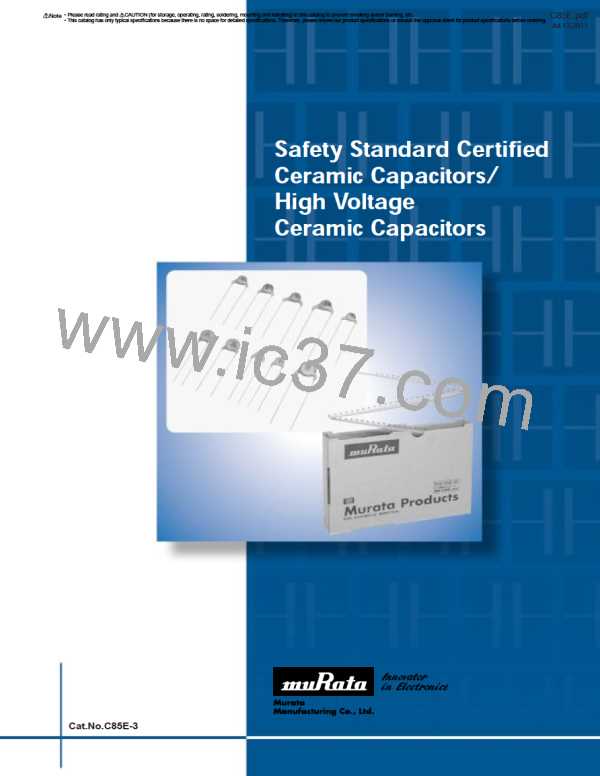• Please read rating and !CAUTION (for storage, operating, rating, soldering, mounting and handling) in this catalog to prevent smoking and/or burning, etc.
• This catalog has only typical specifications because there is no space for detailed specifications. Therefore, please review our product specifications or consult the approval sheet for product specifications before ordering.
!Note
C85E.pdf
Jul.13,2011
Safety Standard Certified Type KY/KH/KX Specifications and Test Methods
Type KY/KH/KX Specifications and Test Methods
Operating Temperature Range: -25 to +125°C (-25 to +85°C for UL standards )
No.
Item
Specifications
Test Method
The capacitor should be visually inspected for evidence of
defect.
Dimensions should be measured with slide calipers.
No visible defect, and dimensions are within
specified range.
1
Appearance and Dimensions
2
3
Marking
To be easily legible
The capacitor should be visually inspected.
Capacitance
Within specified tolerance
Char.
B, E
F
Specifications
D.F.V2.5%
The capacitance, dissipation factor and Q should be measured
at 20˚C with 1±0.1kHz (char. SL: 1±0.1MHz) and AC5V(r.m.s.)
max.
Dissipation Factor (D.F.)
Q
4
5
D.F.V5.0%
QU400+20C*1(CF30pF)
4
SL
QU1000
(CU30pF)
The insulation resistance should be measured with
DC500±50V within 60±5 sec. of charging.
The voltage should be applied to the capacitor through a
resistor of 1MΩ.
Insulation Resistance (I.R.)
10000MΩ min.
The capacitor should not be damaged when the test voltages
from Table 1 are applied between the lead wires for 60 sec.
<Table 1>
Between Lead
Wires
Type
Test Voltage
For lead spacing F=5mm AC2000V(r.m.s.)
For lead spacing F=7.5mm AC2600V(r.m.s.)
AC2600V(r.m.s.)
No failure
KY
KH
KX
AC4000V(r.m.s.)
First, the terminals of the capacitor
should be connected together. Then,
as shown in the figure at right, a metal
foil should be closely wrapped around
the body of the capacitor to the
distance of about 3 to 6mm from
each terminal.
Then, the capacitor should be inserted
into a container filled with metal balls
of about 1mm diameter. Finally, AC
Dielectric
Strength
6
Metal
Foil
about
3 to 6mm
Metal
Balls
Body
Insulation
No failure
voltage from Table 2 is applied for 60 sec. between the
capacitor lead wires and metal balls.
<Table 2>
Type
KY
KH
Test Voltage
AC2600V(r.m.s.)
AC2600V(r.m.s.)
AC4000V(r.m.s.)
KX
The capacitance measurement should be made at each step
specified in Table 3.
Char.
Capacitance Change
B
E
F
Within ±10%
<Table 3>
+20
–55
+30
–80
Within
Within
%
%
Step
Temperature (ºC)
7
Temperature Characteristics
1
2
3
4
5
20±2
-25±2
20±2
85±2
20±2
(Temp. range: -25 to +85°C)
Char.
Temperature Coefficient
SL
+350 to -1000ppm/°C
(Temp. range: +20 to +85°C)
The lead wire of a capacitor should be dipped into molten
solder for 2±0.5 sec.
The depth of immersion is up to about 1.5 to 2.0mm from the
root of lead wires.
Temp. of solder: Lead Free Solder (Sn-3Ag-0.5Cu) 245±5°C
H63 Eutectic Solder 235±5°C
Lead wire should be soldered with uniform coating
on the axial direction over 3/4 of the circumferential
direction.
8
Solderability of Leads
*1 "C" expresses nominal capacitance value (pF).
Continued on the following page.
13

 MURATA [ muRata ]
MURATA [ muRata ]